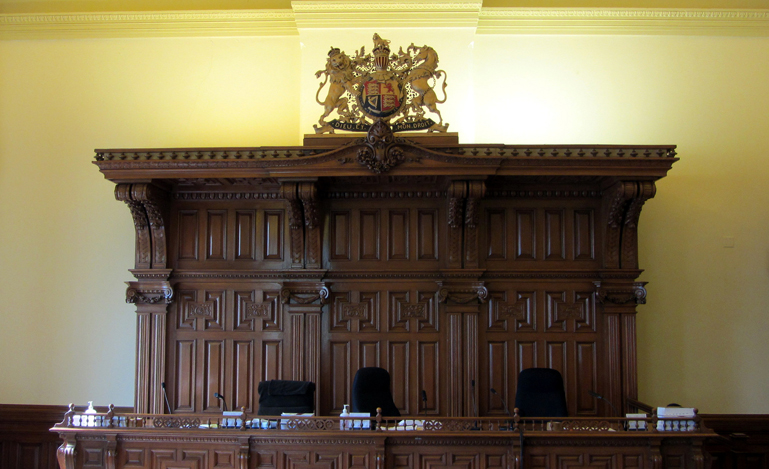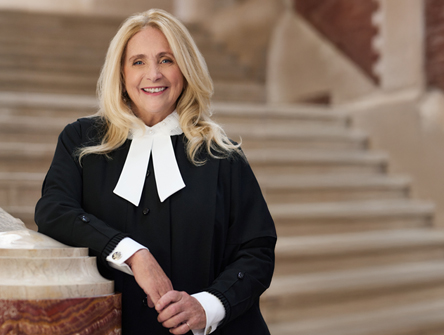Trial and error: criminal justice reform
As C-75 inches through Parliament, lawyers across the country are gearing up to convey to the government just what’s wrong with the bill.

At the end of March, the Trudeau government introduced new legislation that it claims will modernize the criminal justice system, reduce court delays, reduce the overpopulation of Indigenous people in Canadian jails, clean up the Criminal Code, and ensure a broader representation of marginalized people in the court process. Bill C-75 would, it promised, “transform the criminal justice system to make it more efficient, effective, fair, and accessible.”
It was ambitious language, and came at the culmination of more than a year of consultations and conversations between the department of justice and lawyers across the country. The reviews have been less enthusiastic.
CBA National canvassed a number of defence lawyers who routinely deal with the processes that C-75 addresses. Few aspects of the bill have garnered accolades, particularly among defence lawyers. Even well-received measures are dismissed as insufficient, or overdue.
Some critics are even warning that C-75 would exacerbate some of the problems it seeks to fix: lengthening court delays, entrenching a lack of diversity, and disadvantaging accused at trial, especially those with less resources to fight the charges against them.
C-75 is about to go to second reading in the House of Commons, and is not expected to become law until the fall, at the earliest. As it inches through Parliament, lawyers across the country are already gearing up to convey to the government just what’s wrong with the bill.
A call to act
When the Liberals first won power, in 2015, they did so on a platform that was relatively light on specifics vis-a-vis criminal justice reform.
But since her installation as Justice Minister, Jody Wilson-Raybould has had her plate full: From drawing-up legislation to govern medical assistance in dying, to marijuana legalization, the framework around the inquiry into murdered and missing Indigenous women and restoring the Court Challenges program.
Wilson-Raybould was also tasked in her mandate letter, issued by the prime minister, with conducting “a review of the changes in our criminal justice system and sentencing reforms over the past decade.”
The letter laid out a variety of objectives and underscored that the reforms should foster restorative justice, promote fairness for Indigenous offenders, and improve conditions in Canada’s jails. Her office launched national consultations to find a solution to the problems that plague Canada’s justice system.
At the top of the list of concerns are endemic court delays, which have laid to slews of charges being stayed due to new timelines set in R. v. Jordan; perceived anti-Indigenous bias, as evidenced by the verdict in the murder case of Colten Boushie; and chronic overpopulation in Canada’s jails.
A summary of those consultations notes consistent themes coming from many of the lawyers who participated in the Justice Canada-led roundtables. “Almost all roundtable participants stressed the same major concern. They said that most people who come in contact with the criminal justice system are vulnerable or marginalized individuals,” the final report reads. Mental health, addiction, poverty, homelessness were all common themes. Diversion for those cases was stressed as a solution.
To that end, the respondents said that legislation passed in recent decades had unfairly targeted those groups, and affected the efficiency in the delivery of justice as a result.
Another common refrain is that the Criminal Code needs to be cleaned up, and that many of the mandatory minimum sentences it prescribes should be axed. There are also recommendations that Crown counsel pre-approve charges before they are laid.
Many of the suggestions were not, in and of themselves, transformative or game-changing. But taken together, they would amount to significant reform.
The final version of C-75, however, carried roughly a half-dozen of the dozens of recommendations voiced in the consultations.
Some of the more discussed changes that made their way into the bill — the end to preliminary hearings or the end of peremptory challenges for jury selection — weren’t featured in the report at all, and were vocally opposed by many prominent lawyers.
Bail and administration of justice offences
Citing the mounting pressure to tackle court delays and ensure that most — if not all — cases meet the timelines set out in R. v. Jordan, Ottawa is endeavouring to end some of the routine and systematic procedures which put accused and convicted offenders back behind bars, simply for breaching the conditions of their bail or release.
Justice Canada has observed more than a 25 per cent increase in those charged with administration of justice offences over the last decade. Those offences are involved in a quarter of all criminal cases. The majority of those cases are non-violent offences, such as where an accused struggling with addiction relapses, even after being ordered to stay away from drugs; or where a convicted offender misses a sentencing hearing. Ottawa is hoping to build in some leniency.
C-75 lays out more specific guides to judges on what constitutes proportional and reasonable bail conditions, and allows police to lay their own conditions without prior approval from the courts. It also seeks to speed up and simplify how to apply for bail.
Marco Mendicino, a former Crown attorney and currently the Parliamentary Secretary to the Minister of Justice, phrased the change in an op-ed to the Toronto Sun: “Bill C-75 takes aim at redundant breach hearings and restoring some common sense to bail. It legislates a ‘principle of restraint’ so that only those conditions which are necessary to protect public safety are imposed. And where there is an alleged breach, police and prosecutors will be given new tools to either enforce the condition, or modify it where appropriate.”
Ottawa is also looking to end the practice of automatically charging and convincing those who contravene their conditions or who miss a court appearance. Instead, the legislation seeks to divert those accused into a hearing, where the judge will have more flexibility to review and change the existing conditions instead of laying new charges. The courts and police would be required to do so with the person’s circumstances in mind — namely Indigenous identity, mental health background, addiction issues, and homelessness.
Michael Spratt, a partner at Abergel Goldstein & Partners in Ottawa and a vocal critic of C-75, says there’s much to like about these changes. “It is positive to give discretion to not lay charges,” he says, adding however that it would have been better to just “remove stupid non-violent, non-dangerous breaches from the code all together.” Hearings for those who breach their conditions will continue to eat up court time, and could still well result in charges laid. That would leave non-violent offenders exactly where they are now.
Wilson-Raybould told reporters after tabling the bill that reforms would amount to a “call to action for all actors in the justice system,” and would constitutes a culture shift around release conditions and bail.
Peremptory challenges
C-75 aims to abolish the ability of both Crown and defence counsel to launch peremptory challenges during jury selection.
That legislative solution was rolled out after the acquittal of Gerald Stanley, charged with the murder of Colten Boushie, a 22-year-old Indigenous man who had been on Stanley’s property, uninvited, when the farmer opened fire, killing him. The jury that acquitted Stanley was all-white, and the conversation turned to the jury-selection process. Specifically, peremptory challenges.
As the media reported at the time, peremptory challenges can be used to reject jurors based on their gender and race. That led them to becoming a rather obvious target for criminal justice reform.
While C-75 does not end the practice of challenges for cause, whereby counsel can request that all jurors be questioned on a very specific question of bias — racism against Indigenous people, for example — but that practise is used less often, and those challenges are decided by the judge, not the lawyers themselves.
Leonardo Russomanno, who practises criminal defence in Ottawa, says peremptory challenges are a safety valve for those who make it through for-cause challenges. The legislation does appear to contemplate some new power for the judge to exclude jurors, he says, and the standard is “vague.”
Fundamentally, he argues, lawyers are better placed to make the decision, as it is their client’s life on the line.
Sean Robichaud, who runs his own criminal defence practice in Toronto, says eliminating peremptory challenges is a simplistic and counterproductive conclusion.
Robichaud brought me to a downtown Toronto courthouse to see first-hand how peremptory challenges can be used — but not necessarily as they’ve been billed. In the courtroom were dozens of potential jurors, armed with their summons and — in many cases — with excuses for why they would be unable to sit on the jury. But for potential juror after potential juror, either the Crown or defence counsel challenged their inclusion on the jury. Robichaud, in nearly every case, successfully predicted which candidates would be challenges — and by whom — and which would be sworn in to the jury. It wasn’t gender or race, however, that appeared to inform the challenges. A university professor was challenged by the Crown (too analytical, Robichaud said.) A retired civil servant was challenged by the defence (too deferential to authority.)
The jury that took shape that afternoon was predominantly, but not entirely, white — but so was the jury pool. Had the court simply sworn in the first 12 people who were able to sit on the jury (plus two alternates) there is an equal, perhaps higher, chance it would have lacked any diversity. Because jury duty pays so little, and can be time-consuming, many who work low-income jobs, are precariously or self-employed, or have dependants, are excused.
Ryan Handlarski, who also practises criminal defence in Toronto, comes at it from a different perspective. “If I am representing a black accused or an Aboriginal accused and they, for example, asked me to get as many non-whites on the jury as possible, what is the problem with that? It’s their trial,” Handlarski says. “They are the ones that may lose their liberty and have their reputation destroyed.”
But there’s two sides to that coin. Indeed, Robichaud said he regularly uses the peremptory challenges to ensure that the jury does not remain all-white, or all-male. He said the Crown does the same. Sometimes one side may seek a certain jury breakdown and the other side may try for a very different composition. But therein comes the game theory: If it becomes clear that the Crown is trying to stack the jury with a specific type of person, it will use its challenges to disrupt that tactic.
Allison Craig, a partner at Lockyer Campbell Posner, recalls a specific case in a blog posted in March. “I will never forget walking into the courtroom in a small Ontario city with my black client several years ago to select a jury and seeing 199 white faces staring back at me,” Craig writes. “Only one out of the 200 potential jurors was black. My client was understandably petrified. I was able to use the peremptory challenges available to me to allow the one black man to be on the jury. Had the challenges not been available, my black client would have been tried by an all white jury.”
According to Edward Prutschi, a partner with Bytensky Prutschi Shikhman, the “reactionary” elimination of peremptory challenges is a “classic knee-jerk failure.” While he doesn’t doubt that the defence in the Boushie trial may have used its peremptory challenges to its own ends, he says it’s not representative of the “important” tool more broadly — one “used in the vast majority of cases by the very marginalized and racialized groups the changes seek to support.”
Both Robichaud and Prutschi agree that the change will do little to improve the lot of Indigenous people in the justice system. “Indigenous defendants staring out at jury arrays that do not represent their lived experience will sorely miss the opportunity to bring some balance back to their panels,” Prutschi said.
Scott Reid, a partner at Edward R. Royle and Partners, wrote at length on the various upsides of peremptory challenges. “Peremptory challenges are also important for weeding out jurors who are evidently hostile to the defendant,” he writes. “It may not be for any ground that is otherwise challengeable. In other words, the juror may not be biased on grounds of race, or publicity. But the juror may glare at your client during selection. The juror may appear confused, or not able to follow instructions. Those are often not the sorts of jurors counsel wants on their client’s jury.”
The bottom line is that “peremptory challenges are overwhelmingly used to get an impartial jury,” says Reid. While the government hasn’t said much on the issue of eliminating peremptory challenges, Wilson-Raybould justified the change on grounds that it would “assure that the jury selection process would become more transparent by requiring prosecutors are defence lawyers to present their motives or their reasons for excluding a jury.”
Preliminary hearings
One of the more controversial sections of C-75 axes preliminary hearings for all cases, barring cases that could come with life imprisonment. Even then, the court will have increased authority to reduce their scope. Prutschi says that, from his understanding of the legal consultations untaken by the federal government, “no one (at least on the defence side) thought scrapping prelims was a good idea.” While Ottawa has taken aim at the pre-trial hearings as a sort of bugaboo of court delays, many in the legal community, argue that jettisoning preliminary hearings won’t have the impact that C-75 envisions.
As Ian Carter, partner at Bayne Sellar Boxall and Vice-Chair of the CBA National Criminal Justice Section, wrote in CBA National in 2017: “Recent research published in the Canadian Journal of Criminology and Criminal Justice suggests that only 25 per cent of eligible cases opt for a preliminary inquiry. Further, at most two per cent of all court appearances are used for preliminary inquiries.”
Reid, in a blog posted to his firm’s site before C-75 was introduced, took aim at the abolition of preliminary hearings as a “ridiculous proposal.” Now Reid says the end of preliminary hearings for most cases will shift a burden, at least in Ontario, onto the Superior Court.
At present, many cases get resolved during the preliminary hearing at the lower court. If there is no weeding-out of those cases, the volume before the Superior Court could explode. “That court can simply not handle a significant increase in its caseload,” he says. He also suspects that the 30-month ceiling for a normal trial, set out in Jordan, may go out the window. “That 30 month Jordan limit in the Superior Court is based on a 2-stage process, 18 months in provincial court followed by another 12 in superior,” he says.
Prutschi calls the move “yet another example of the government’s incomprehensible approach to trial efficiency.” He cites the litany of cases that get “resolved, curtailed, or entirely discharged” at the preliminary level. “It is mind-boggling that anyone who has worked in the justice system could think cancelling prelims will rescue the system from its trial delay crisis.”
The one obvious downside of the preliminary hearing is requiring witnesses and victims to appear twice. The Justice Minister believes that by removing it for most cases it “will reduce revictimization of witnesses by ensuring speedier trials and reducing the need for vulnerable witnesses to testify twice.”
And yet, as Christine Mainville, a partner with Henein Hutchison, argued before the Senate legal committee last year, bringing forward witnesses at the preliminary stage is actually a benefit to the Crown, as well as the defence. Preliminary hearings, she said, “allow the parties to focus their case for trial and narrow the issues before the proceedings in Superior Court. In particular, they allow Crown prosecutors to assess the strength of their case by seeing their witnesses testify.”
Hybridization
Proponents of eliminating many mandatory minimum sentences cite the issue of prison overpopulation in support of their argument. But C-75 leaves those charges mostly intact. Instead, the bill seeks to take most indictable offences punishable by 10 years or less and turn them into hybrid offences. The bill also increases the maximum penalty for summary convictions to two years less a day, up from its current six months, as well as extending the limitation period for those offences to 12 months.
Though the change has drawn less attention than other elements of the bill, Prutshi says it is critically important. “For a government that pays lip service to the importance of access to justice, it is stunning to see such ignorance of the negative consequence of this change,” he says. He notes that the bill could significantly increase the amount of jailtime for summary offences, and “they will be doing it without the benefit of paralegals, articling students and law students, who are not permitted to act on such matters.”
Those students and paralegals can only act for accused facing six months or less in jailtime. He calls it “a recipe for disaster.” Reid notes that those lacking more affordable representation options will invariably end up representing themselves. “Self-represented trials take about twice as long as trials with counsel, on average,” Reid says. “So wait for a huge influx of self-represented people in court, eating up hugely disproportionate amounts of court time, leading to further and further delays of other matters. Criminal courts are soon going to look like family courts.”
Reid also notes that, despite Wilson-Raybould’s mandate letter specifically prioritizing the reduction of mandatory minimums, “there is not one mandatory minimum sentence revoked by this legislation.”
Wilson-Raybould addressed that omission, when asked by reporters in March. She alluded that there could be further legislation, but said little else beyond that. “Mandatory minimum penalties and sentencing reform needs to be dealt with,” she told reporters. “We're going to do it in a responsible manner and this is something that is part of our ongoing review of the criminal justice system. The bill also boosts the penalties for repeated instances of intimate partner violence, and includes the nature of that violence as a factor in sentence.
Sarah Leamon, a criminal defence lawyer and chair of the board at Vancouver’s PACE Society, says that imposing a reverse onus at sentencing for those convicted of intimate partner assault is ripe for a challenge. “The presumption is in favour of detention from the start,” she wrote in the Huffington Post. “Imposing a reverse onus on bail applications for some offenders, and not others, is problematic. If it's to become law, this portion of the bill is likely to be challenged as a beach of Charter protections. There is a reasonable likelihood that it will be ultimately struck down.”
Police evidence
C-75 makes a slate of amendments that codify and promote practices already in play, expanding the ability for defendants to appear by video link and expanding judges’ case management powers. One seemingly-innocuous change, which allows the submission of “routine police evidence” in writing, has some lawyers fuming.
Stephanie DiGiuseppe, who specializes in both criminal and constitutional law, writing in the Toronto Star, called this change “the most troubling aspect of C-75.” “The definition of routine matters is so broad it could cover the entire spectrum of police evidence,” she writes. Given that the officers will not need to appear, it means the defendant would need to apply to cross-examine the officer. Those applications could “clog up the system,” DiGiuseppe writes.
Without the ability to cross-examine officers and probe how they came to the evidence in question could strike at the very core of the power of cross-examination, she argues. “Without this form of transparency, abuses will have fertile ground in which to flourish.”
Reid concurs. “The hallmark of criminal justice is the ability to confront the accuser — often the police — with cross-examination. Effectively, these provisions try to neuter that ability by forcing the defence to ask to cross-examine the officers.” Russomanno notes that requiring counsel to apply to cross-examine will only make trials longer, and more complex. “It’s an odd way to streamline things, if that is your aim,” he says.
The verdict
The government has already begun selling C-75 as ambitious reform. But given the level of opposition that C-75 has seen from the legal community, it seems all but certain that the bill will run into pushback at committee.
Political opposition, however, is fractured. The Senate has already voiced concerns about the bill, with four senators from the Senate Human Rights Committee — Wanda Thomas Bernard, Jane Cordy, Nancy Hartling and Kim Pate — penning a letter asking that the government include firm restrictions or an outright ban on the use of solitary confinement in the legislation. That recommendation was included in the consultation report, but was left off the final legislation.
The Conservative in the House, meanwhile, have taken a very specific tact on the bill, alleging it lightens jail terms for some offenders.
The NDP, for its part, largely took aim at the fact that the bill didn’t axe mandatory minimums.
It’s unclear at this point whether there would be sufficient political will to mount a significant campaign against the bill within Parliament. Judging by the legal response, however, that pressure may well come from the outside.


